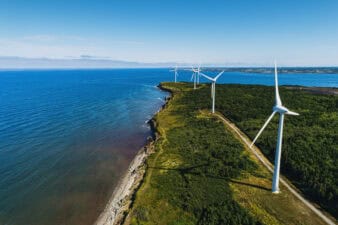Green power investors have a strong buy in Algonquin Power & Utilities (TSX:AQN)(NYSE:AQN). Let’s review some of its strong points before comparing it with three of its closest competitors.
Diversification makes for a strong dividend
Algonquin’s revenue is divided among three distinct business segments: Distribution, generation, and transmission. These three facets make Algonquin a powerfully diversified stock. Its inclusion on the TSX 60 Index also makes Algonquin part of the top cadre of Canadian names to buy for their defensively large-cap status.
Algonquin’s American operations include water, natural gas, and electricity distribution utilities. Their regulated status should be reassuring to the low-risk investor seeking buy-and-forget dividends. These operations add to Algonquin’s diversified asset portfolio, spreading risk and strengthening payment reliability. This segment of Algonquin’s business is heavily weighted by natural gas.
However, when you look at Algonquin’s generation segment, it’s clear that the emphasis is on renewable energy. Electricity sales are powered by hydroelectric, wind, solar, and thermal power generation. Again, this section is also weighted more by one source than another; here, the focus is on wind farms.
Transmission makes up the remainder of Algonquin’s business, with both natural gas pipelines and electricity transmission falling within its purview. A 4.7% dividend yield is tasty enough for a long-term position.
Overall, Algonquin is moderately well valued, pays an adequate dividend, and satisfies a growth thesis. But how do its competitors stack up?
Three great stocks for green power exposure
Northland Power (TSX:NPI) pays a decent dividend and has a strong track record. It doesn’t match Algonquin in terms of value, with a P/B of 5.6 times book compared with Algonquin’s twice-book share price. Its mix of assets covers similar ground to Algonquin’s, though with strong international partnerships and a growing windfarm empire.
Potential five-year total returns of 145% underscore just why Northland is one of the top green energy stocks to buy in 2020. Algonquin could be looking at similar returns of around 149%, though, making this one too close to call. Overall, Algonquin is a stronger all-rounder, though Northland’s deal-making in the wind farm space is enticing.
Polaris Infrastructure is an extreme value play for green energy coverage. It’s currently selling at a discount of 80% below fair value. This is clearly one to add to a list of deeply oversold assets. Its outlook does not match those of Algonquin or Northland, though
Furthermore, Polaris’ balance sheet is marred by a high debt to equity ratio of 85%. Still, its exposure to geothermal and hydroelectric assets and 6% dividend yield are appetizing.
Brookfield Renewable Partners stock comes with the high pedigree of a world-class asset management name, as well as defensive variety across asset types. This is the number-one stock to buy if you want instant exposure to green energy assets across the Americas, Europe, and Asia. However, beyond a 4.6% dividend and strong diversification, Brookfield falls down on valuation selling at double its book price.
Algonquin sizes up favourably against its closest analogues, making it a solid buy in the green energy space. Investors should weigh their exposure and consider adding shares in Northland Power, Polaris, and Brookfield Renewable Partners for a comprehensive spread of renewable power assets.







